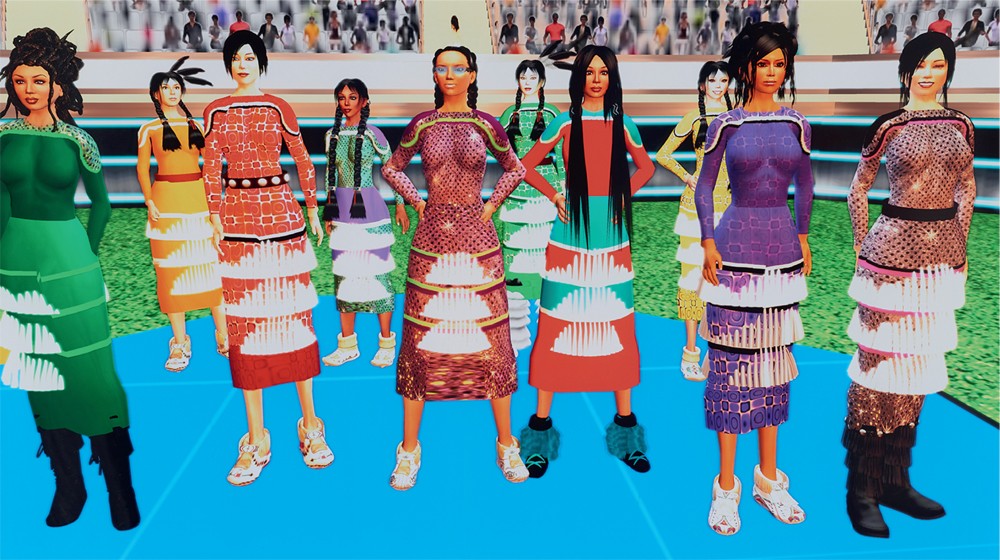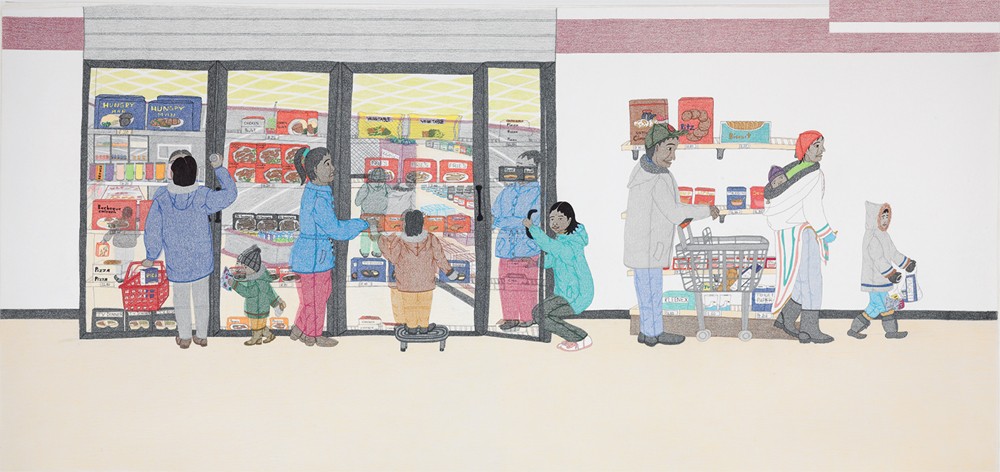Taking Back the Territory

Ursula Johnson, Mi’kmaq, Between My Body and Their Words, 2017, photography on vinyl, variable dimensions. All images courtesy MAWA.
MAWA (the letters stand for “mentoring artists for women’s art”) is in its 34th year of operation and on June 1, 2018, will launch the “National Billboard Exhibition Project,” a two-month public celebration of the art of Indigenous women that will be visible across the country. The Winnipeg-based organization has always been among the most vital and inventive artist-run centres in the country, but in the last few years it has put its creative pedal to the floor and has come up with projects of lasting national significance. Last year it released the book Desire Change: Contemporary Feminist Art in Canada, a 328-page history published by McGill-Queen’s University Press that is the first comprehensive attempt to discuss women’s art in Canada. Only a year later it is about to place 50 images in digital rotation on 178 billboards from one end of the country to the other, top to bottom, in a fulfillment of Canada’s self-identifying geography as running from see-to-shining-see.
The billboard project is called “Resilience” and the name was carefully chosen to reflect a past condition and a future prediction. The guest curator for the project is Lee-Ann Martin, one of the country’s most admired Indigenous curators. When asked two years ago by Shawna Dempsey (who co-directs MAWA with Dana Kletke) if she would be interested in curating the project, she “thought about it for two seconds before saying yes.” From the beginning her interest was in Indigenous women artists, an emphasis that fit perfectly with MAWA’s mission and mandate. “Indigenous women have been excluded, undervalued and misrepresented for too long,” she says, “and it is only recently that there has been an increasing awareness and respect for their art. I thought this project was very important because it’s happening outside the gallery space, in communities and cities, and along Canada’s roadways.”
The billboards will appear in three formats; the majority will be digital; 24 will be static; and there will be 22 super-boards for mural-scaled paintings like Daphne Odjig’s The Indian in Transition, 1978. The overall geographical placement took into consideration the availability of Pattison billboards, the country’s major provider of this display form; so only one image will be visible along the infamous Highway of Tears in northern British Columbia. The distribution across the country reflects certain wished-for demographics: places where Indigenous and non-Indigenous populations cross over and locations that are well-travelled and accessible. So there will be billboards on the Trans-Canada Highway and in downtown Regina.

Skawennati, Kanien’kehá:ka (Mohawk), Jingle Dancers Assembled, 2011, print, 91.5 x 157 cm. Collection of Indigenous and Northern Affairs Canada.
The original plan was to launch “Resilience” during the year of the celebrations but the scale of the project and the demands it put on the organization made that improbable. As it turned out, the delay turned out to be an advantage. “We didn’t want this project to be looking back, like a lot of the 150 projects,” says Kletke, who was the originator of the idea of seeing women’s art everywhere on billboards. “Instead we wanted to be looking forward for the next 150 years.”
Dempsey says they imagined a family on a road trip over the summer where “a little girl looks out through a rain-streaked window, sees a billboard, and is moved or energized or troubled by it.” The range of images the fictional little girl will see is richly eclectic. Martin’s choices are celebratory, beautiful, challenging and, in some cases, confrontational.
There are iconic images, like Shelley Niro’s The Rebel, 1982; Rosalie Favell’s I awoke to find my spirit has returned, 1999; Dana Claxton’s Baby Girlz Gotta Mustang, 2008; and Rebecca Belmore’s Fringe, 2008. This last work shows a supine Indigenous woman lying on her side and seen from the back, her hips covered by only a white cloth. Across her back running diagonally from shoulder to waist is a stitched scar, from which red beaded lines hang like traces of drying blood. They are the “fringe” from the title, and Belmore reads them as evidence of both wounding and mending; in her view, “she will turn her back on the atrocities inflicted upon her body and find resilience in the future.” (This description is posted on the MAWA website, as are all 50 billboards along with statements by the artists of what they had in mind when they made the images. It is an indispensible site.)
A project this good is bound to attract considerable attention and not all of it will be positive. Martin has chosen images that are political and in-your-face. The billboard of Danya Danger, a Métis-Saulteaux-Polish artist, is called Big’Uns—Adrienne. The title plays off the language of hunting culture where antlers are referred to as “big’uns,” but in this image a powerful, oiled and naked Indigenous woman covers her midsection with a rack of antlers while her long black hair deftly covers her upper body. Danger is a queer two-spirited artist whose work is a celebration of “trans, non-binary and women-identified people,” and her image is doubly provocative. Choosing her was both courageous and brilliant. Martin and MAWA are prepared for the discussions that could emerge. “We hope that the images will spark a conversation. As long as people’s concerns are voiced publicly so that we, as organizers, and Danya can respond to the issues and misunderstandings that might come up.”

Mary Anne Barkhouse, Kwakiutl, Dominion, 2011, photograph, 91.4 x 121.9 cm.
There are some things that are difficult to misunderstand. Both Martin and Dempsey recognize that any image of the land made by an Indigenous artist is political. “We’re working for the day when it won’t be,” says Martin. “To put a landscape in an urban environment made by an Indigenous person does talk about territory,” adds Dempsey, “it does talk about land since colonization.”
Despite the inescapable politics, all three organizers agree that “Resilience” is first of all an art project, which is why next to each image the artist’s name, Indigenous affiliation and the designation “artist” is included. Martin’s conviction is that each of the 50 images embodies the strength, endurance and adaptability of Indigenous communities and the women who are at their centre. She and her colleagues at MAWA have conceived and executed an inspirational project. It’s hard to imagine a project better positioned to start the new chapter of reconciliation of which our country is in desperate need. It is the purest and best form of advertising. ❚

Annie Pootoogook, Inuit, Cape Dorset Freezer, 2005, coloured pencil crayon, metallic ballpoint pen and graphite on wove paper, 111.5 x 233.1 cm. Collection of the National Gallery of Canada, Ottawa.

